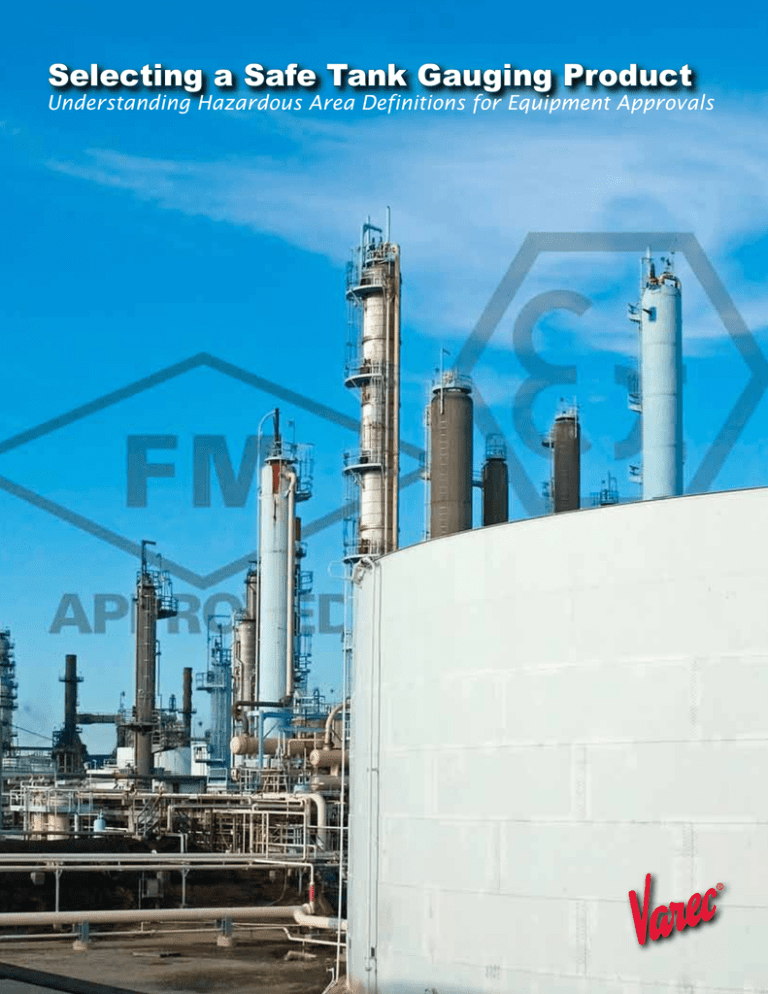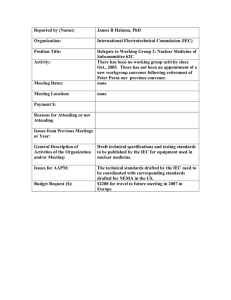
Selecting a Safe Tank Gauging Product
Understanding Hazardous Area Definitions for Equipment Approvals
Hazardous Area Approvals
A Worldwide Requirement
There are many environmental considerations within a location that define a specific type of approval
that is needed. The ATEX Directive, which is based on the International Electrotechnical Commission
(IEC) standard, defines requirements within the European Union (EU). In the U.S., hazardous area
requirements are defined by the National Electric Code, as set forth by the National Fire Protection
Association (NFPA). Other countries may use IEC standards or have their own code of standards, such
as the CEC in Canada or Russian GOST codes.
Hazardous Areas are locations where the potential for
fire or explosion exists because of liquids, gases, dust
and materials in the atmosphere that could be easily
ignited.
In North America, hazardous areas are typically
separated by classes, divisions and groups to define
the level of safety required for equipment installed
in these locations. Classes define the general form of
the flammable materials in the atmosphere. Divisions
define the probability of the presence of flammable
materials. Groups classify the exact
flammable nature of the
material.
The more recent NEC®
Standard 505 attempts to
harmonize American and
international classifications
by using zone classifications.
In Europe and countries outside of North America,
zones are used to define the probability of the
presence of flammable materials. Protection Types
denote the safety method used for the device. Groups
classify the exact flammable nature of the material,
but these groups are separated differently than
North American Groups. Lastly, both systems use
temperature codes to identify the maximum surface
temperature of the device, which ensures the specific
gas or vapor encountered in the application will not
ignite.
Independent test laboratories perform testing and
inspection before approving equipment. The Varec
6000 Servo Tank Gauge is approved by multiple
laboratories to different standards required
worldwide, such as explosion proof/flame proof,
as well as being intrinsically safe. Ensure the
equipment you select carries clear identification of
the pertinent approvals standard.
Hazardous Area Approvals
Flammable Materials and Ignition Sources
The application of hazardous area classification and appropriate standards is the responsibility of the
end user. For detailed information, see specific standards published by the relevant organizations,
for example, the American Petroleum Institute (API RP 500) provides a recommended practice for
Classification of Locations for Electrical Installations at Petroleum Facilities Classified as Class I Division
I and Division 2.
Zones and Divisions
Classes and Groups
NEC® 500 hazardous locations are established into two
divisions (1 & 2) based upon the presence of flammable
materials under either normal or abnormal conditions,
maintenance, repairs or leakage. For countries that
utilize IEC or ATEX standards, three Zones (0, 1 & 2)
define how often the hazard is present. The aim of
NEC, ATEX and IEC standards is to achieve safety by
identifying areas where ignition sources should be
eliminated or ensuring that the ignition source is noneffective. ATEX and IEC separate NEC®’s Division 1 into
two distinct zones (0 & 1). Zone 0 defines locations
that are most hazardous because they continuously
remain hazardous under normal conditions. Therefore,
ATEX and IEC restrict the method of protection in
Zone 0, while permitting a more relaxed method of
protection in Zone 1 locations. Zone 0 provides a
marked difference between NEC® and EU/
IEC standards. Zone 1 locations can
be treated as roughly equivalent
to Division 1 locations and
Zone 2 locations roughly
equivalent to Division 2
locations. For most
situations, equipment
certified for use
in a Zone 0 can also be
installed in a Zone 1 or 2.
NEC® 500 uses Classes (I, II, III) and Groups (A-G)
to identify the specific hazard. Classes are used to
represent the type of material (gases, dusts, or fibres).
Groups are used to represent “how ignitable” a gas or
gas mixture is, with “A” being the most ignitable and
“G” the least ignitable.
The IEC and ATEX ‘Zone’ systems identify the hazard
by two main groups. Group I gases are firedamp
methane found in mining/underground locations and
Group II are all other explosive gases found in surface
industries, such as a terminal or refinery. Group II is
divided into three subgroups (A, B & C) arranged in
order of hazard due to threat of ignition with “A” being
the most difficult to ignite and “C” the easiest to ignite.
NEC® 505
NEC® Standard 505 (Zone classification)
uses three parallel Zones (0, 1 & 2) to
define location, while a single class
(1) with four sub groups (A-D) are
more closely aligned with EU/IEC
Groups IIA, IIB and IIC.
Safety standards apply to all electronic equipment
and also some mechanical equipment. The Varec 2500
Automatic Tank Gauge, which is mechanically operated,
but can also be connected to tank gauge transmitters is
ATEX approved for use in hazardous areas.
Flammable Material is Present...
IEC & EU
Continuously
Intermittently
Abnormally
Zone 0
Zone 1
Zone 2
NEC 500
®
NEC 505
®
Division 1
Zone 0
Division 2
Zone 1
Zone 2
Typical Gas
NEC® 505, EU & IEC
NEC® 500
Acetylene
Group IIC
Class I / Group A
Hydrogen
Group IIB + Hydrogen
Class I / Group B
Ethylene
Group IIB
Class I / Group C
Propane
Group IIA
Class I / Group D
Hazardous Area Approvals
Types of Protection
Depending on the type of protection required for a hazardous area, a device should be selected that
offers the corresponding electrical or mechanical design feature that is approved for safe operation.
For applications normally encountered by Varec in tank farms, terminals and refineries - intrinsic
safety, explosion proof/flame proof are the most common, but non-incendive, encapsulation, purging,
oil immersion, powder filling or increased safety may also be a requirement depending on the
application.
Intrinsic Safety
Explosion Proof and Flame Proof
Intrinsic safety is one method of protection for devices
that operate in areas with flammable gases, vapors
and liquids, such as where fuels are stored and
manufactured. An intrinsically safe (i.s.) specification
or approval rating means that the device is incapable
of releasing sufficient electrical or thermal energy to
cause ignition of the most easily ignited concentration
of gas present.
Both Explosion Proof and Flame Proof are used to
define the ability of a device enclosure to withstand
an explosion and restrict the propagation of the
explosion. The certification takes into account
the enclosure’s ability to restrict the flame path,
the ignition energies of the gas, the volume of the
enclosure and the normal operating temperature.
When all factors are considered, if a gas or vapor
ignited within the device, the explosion
would need to be contained internally.
The IEC Zone system does not allow this
“flameproof” methodology in Zone 0.
This type of protection is referred
to by IEC as “Ex i.”, by NEC® (500)
as “IS” and NEC® (505) as “AEx i”.
This type of protection is referred to as
“Ex d” by IEC, “XP” by NEC®500 and “AEx d”
by NEC®505.
Explosion/Flame proof and intrinsic safety concepts can be combined for a
single device. The Varec 4590 Tank Side Monitor (TSM) is approved as a
Flame proof device that is also intrinsically safe. The 4590 TSM also acts
as an intrinsically safe power supply for connected devices, such as radar
tank gauges, temperature and pressure sensors.
Protection Type
NEC® 505, EU & IEC
IEC Standards
NEC® 500
Intrinsic Safety
Ex i
EN 60079-11
(IS)
Non-incendive
-
Non Sparking
Ex nA / AEx nA
Explosion Proof
-
Flame Proof
Ex d / AEx d
(NI)
EN 60079-15
(XP)
EN 60079-1
Hazardous Area Approvals
Ambient Environmental Considerations
In addition to approvals requirements, consider the ambient atmosphere of the application to
ensure that the equipment selected will perform in the environment for which it is intended. Many
environments are arduous and may involve the equipment being subject to extreme high or low
temperatures, demanding weather conditions, immersion in water or chemical/corrosive attack.
Ingress Protection (NEMA)
Temperature Ratings and Codes
Ingress Protection (IP) specified by IEC provide rates for
the environmental (physical) protection an enclosure
provides to its internal components from solids,
liquids, gases and physical impacts. The American
version of IP rating is known as NEMA, but
because the tests and evaluations
for characteristics are
not identical, the IEC
classification cannot be
exactly equated with
NEMA Enclosure Type
Numbers.
A mixture of hazardous gases and air may ignite
when coming in contact with a hot surface. The
condition for ignition depends on several factors,
such as surface area, temperature and concentration
of gas. If the equipment’s T rating signifies the
temperature generated by the equipment is greater
than the ignition temperature of the gas present, the
equipment will ignite the surrounding atmosphere
and cause an explosion. The T ratings of the EU,
IEC and NEC® are, in all practicality, the same.
Approximate NEMA Rating
Equivalent to IP
NEMA rating
IP Equivalent
1
10
2
11
3
54
3R
14
3S
54
4 & 4X
55
5
52
6 & 6P
67
12 & 12K
52
13
54
The device your application demands may not be approved for use
in a hazardous area. In these cases, it may be possible to install
your device in an optional enclosure or case that is ‘approved’
and provides the required protection. The Varec 8130 Remote
Terminal Unit is normally installed in non-hazardous areas,
such as control rooms, but it is also approved for use in Class
1, Division 2 areas when installed in an optional NEMA 4
enclosure.
Temperature Class
Maximum Surface
Temperature
Ingress Protection Codes (IPxy)
NEC® 505,
EU & IEC
NEC® 500
842 °F
450 °C
T1
T1
572 °F
300 °C
T2
T2
536 °F
280 °C
T2A
500 °F
260 °C
T2B
T2C
Character
x=Solids
y=Liquids
446 °F
230 °C
0
None
No Protection
419 °F
215 °C
1
Objects > 50 mm
Vertical (90°) Dripped Water
392 °F
200 °C
2
Objects > 12 mm
Dripped Water (75° to 90°)
356 °F
180 °C
T3A
3
Objects > 2.5 mm
Sprayed Water (30º to 90º)
329 °F
165 °C
T3B
4
Objects > 1 mm
Splashed Water (0º to 90º)
320 °F
160 °C
5
Dust Protected
Low Pressure Water Jets
275 °F
135 °C
6
Dust-tight
T2D
T3
T3
T3C
T4
T4
High Pressure Water Jets
248 °F
120 °C
7
Immersion to 1 m (3 ft)
212 °F
100 °C
T5
T5
8
Immersion beyond 1 m (3 ft)
185 °F
85 °C
T6
T6
T4A
Measurement, Control and Automation
Varec, Inc., deliver measurement, control and automation solutions and professional services for most major oil
companies, defense organizations and airlines worldwide. Varec’s FuelsManager® software applications and hardware
products provide local level management and enterprise visibility of liquid petroleum assets at bulk storage facilities,
marketing terminals, refineries, petrochemical plants and military fuel facilities.
Oil & Gas
Defense
Aviation
Since its founding in 1928, Varec
has been a leading innovator in the
petroleum and chemical sectors,
delivering automated systems and
professional services for tank farm,
terminal and refinery operators and
owners worldwide. Today Varec
provides completely integrated
measurement, control and automation
solutions that are specifically
designed to ensure safe storage and
distribution, track product visibility
and provide accurate accounting
for the local facility operator to the
corporate enterprise. This includes
functionality for:
Defense operations need a fieldproven fuels management system
for real-time, global inventory
visibility and accountability. Varec’s
commercial off-the-shelf solution
provides mission critical functionality
that is essential to air, ground and
marine fueling applications at the
base, tactical command or enterprise
levels. This includes functionality for:
Varec provides aviation application
services designed for airports, airlines
and service providers. The entire
aviation industry can now rely on
a single solution for aviation fuels
management from the fuel farm to
take-off. This includes functionality
for:
•Tank gauging and inventory
management
•Supervisory control and data
acquisition (SCADA)
•Transaction and inventory
management
•Supervisory control and data
acquisition (SCADA)
•Remote or automated, real-time
dispatch operations
•Online or batch-mode paperless
fuel ticketing
•Automatic tank gauging
•Integrated fuel farm and supervisory
control and data acquisition
(SCADA) automation
•Dispatch and automated data
capture (ADC)
•Local fuels reconciliation (ExSTARS
compliant)
•Aircraft Communication Addressing
and Reporting System (ACARS)
messaging and airlines systems
integration
•Overfill prevention, facility
monitoring and release detection
•Terminal and refinery automation
•Enterprise solutions (FuelsManager®
Aviation Application Services)
Varec, Inc. Locations
Corporate Headquarters
5834 Peachtree Corners East
Norcross (Atlanta), GA 30092
USA
Tel: +1 (770) 447-9202
Toll Free: +1 (866) 698-2732
Fax: +1 (770) 662-8939
Houston
5151 San Felipe
Sage Plaza, Suite 1100
Houston, Texas 77056
USA
Tel: (281) 498-9202
Fax: (281) 498-0183
Asia Pacific
Level 8, 91 William St.
Melbourne
Victoria 3000
Australia
Tel: +61 3 8623 6400
Fax: +61 3 8623 6401
Europe
Suite 120, 94 London Road
Headington, Oxford
Oxfordshire, OX3 9FN
United Kingdom
Tel: 0800 0322389
Fax: 0800 0322389
2009© Varec, Inc. All Rights Reserved. This document is for information purposes only. Varec, Inc. makes no warranties, express or implied, in this summary.
The names of actual companies and products mentioned herein may be the trademarks of their respective owners.
Document Code: PRO061GVAE0609




